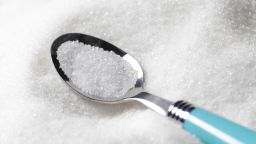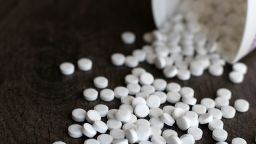The discovery wasn’t intentional — just sloppy safety practices. Chemist James M. Schlatter was hunting for an anti-ulcer drug in his lab in 1965 when he licked his finger to pick up some paper. Astonished by an intense sweetness on his tongue, he soon traced the substance back to a beaker full of aspartic acid and phenylalanine, two naturally occurring amino acids.
As Schlatter studied the mixture further, he found that methanol, which is a simple alcohol also found in fruits and vegetables, seemed to be a key to the powder’s sweetness — and aspartame as a sugar substitute was born.
By 1973, aspartame joined the growing artificial sweetener market, and today we also know it by such brand names as Equal, NutraSweet or Sugar Twin.
What is aspartame?
Aspartame is a non-nutritive sweetener, meaning it contains an extremely tiny or zero amount of carbohydrates and doesn’t provide the body with energy — or calories — as sugar does. However, unlike some artificial sweeteners that are excreted from the body nearly unchanged, aspartame is metabolized and has about 4 calories per gram.

Aspartame is one of six non-nutritive sweeteners approved by the US Food and Drug Administration. The others are acesulfame potassium (sold as Sunett and Sweet One), saccharin (sold as Sweet’N Low, Sweet Twin and Necta Sweet), sucralose (sold as Splenda), neotame (sold as Newtame), and advantame (sold as Advantame).
Two of the six, neotame and advantame, are derived from aspartame but have no calories and are much, much sweeter. While aspartame is approximately 200 times sweeter than sugar, neotame is up to 13,000 times sweeter and advantame is 20,000 times sweeter than sugar.
Sweeteners can be purchased for use in restaurants and homes, but manufacturers often combine a variety of each into their diet drinks and foods to develop a unique taste, according to the American Beverage Association, an industry association that has published an extensive report on aspartame.
Is aspartame bad for you?
A number of studies have found correlations between artificial sweeteners and various health issues, such as migraines, depression, heart disease, cognitive, behavioral and developmental issues, and the development of dementia, diabetes and cancer.
However, the Expert Committee on Food Additives, a joint advisory committee of the Food and Agriculture Organization of the United Nations and the World Health Organization, concluded in 2013 there is no convincing evidence from experimental, animal or human studies that aspartame has adverse effects after ingestion — as long as levels are within the acceptable daily intake of 40 milligrams per kilogram of body weight.
The same conclusion was reached in a recent review of more current studies, all of which showed conflicting results on potential toxic effects of aspartame, said Dr. Francesco Branca, director of WHO’s Department of Nutrition and Food Safety Department in a news briefing.
In the United States, the FDA has set an acceptable daily level of use of aspartame at 50 milligrams per kilogram of body weight (1 kilogram equals 2.2 pounds) and has said all six approved sweeteners are safe as long as they are used in moderation.
Since each type has varying levels of sweetness, the FDA has done the math (PDF) for you: Consume no more than 75 packets a day of Equal or NutraSweet (aspartame); 23 packets a day of Splenda (sucralose), Sweet One (acesulfame potassium) or Newtame (neotame); and 45 packets a day of Sweet’N Low or Sweet Twin (saccharin).
The American Academy of Pediatrics is concerned about the use of such sweeteners by children, which jumped by 200% from 1999 to 2012. The academy pointed out that it’s hard to tell just how much of these substances are being consumed since one or more are likely in most “reduced sugar” and “no sugar” foods and drinks.
“First you have to read the ingredient list,” pediatric cardiologist Dr. Carissa Baker-Smith, director of preventive cardiology at Nemours Children’s Hospital in Delaware, told CNN in a prior interview.
“And then you have to know the names of all the different sweeteners,” she said.” Do people really recognize aspartame and acesulfame potassium?”
Aspartame does have some known health concerns for certain people, the FDA noted. The sweetener should not be used by anyone with the genetic disorder phenylketonuria, certain rare liver disorders or pregnant people with high levels of phenylalanine in their blood, because it doesn’t metabolize properly in those individuals. Wondering how to tell? The FDA requires any food made with aspartame to put that warning on the label.
Recently, published studies have begun to look at whether aspartame and other artificial sweeteners in diet drinks and foods may actually increase feelings of hunger and therefore contribute to increased calorie intake and weight gain.
In May, WHO changed its guidance and announced that non-sugar sweeteners do not help adults or children control weight long-term.
“We did see a mild reduction of body weight in the short term, but it’s not going to be sustained,” Branca, director of WHO’s Nutrition and Food Safety Department, told CNN in a prior interview.
Does aspartame cause cancer?
Animal studies in the 1980s showed no cancer-causing effects from aspartame, even in high doses, and no damage to DNA. Studies over the years, however, have raised a red flag on a potential link to cancer, prompting a new review by WHO.
In 2023, for the first time, WHO’s International Agency for Research on Cancer (IARC) announced that aspartame should be categorized as “possibly carcinogenic to humans” due to a potential link to liver cancer.
The decision, published in The Lancet Oncology, placed aspartame in the same category as red meat and extremely hot drinks over 149 degrees Fahrenheit — meaning the science was not as conclusive as it is for benzene, asbestos, diesel engine fuel, tobacco and outdoor air pollution, all known carcinogens.
Observational studies in humans — which cannot show a direct cause and effect — saw an association between aspartame and liver, breast and lymphoma cancers, as well as an impact on type 2 diabetes. But much more research needs to be done to draw a direct link, Branca said.
According to the FDA, however, aspartame is one of the “most studied food additives in the human food supply.” The agency says on its website that it has reviewed more than 100 studies that assessed the sweetener’s impact on the body’s metabolism, reproductive and nervous systems, and the development of cancer.
One reason for concern is that the methyl group added to reduce bitterness is partially converted into formaldehyde — a chemical that can be toxic in high doses — when metabolized by the body. Drinking 1 liter of diet soda with 600 milligrams of aspartame will be converted into 60 milligrams of formaldehyde, according to a 2021 narrative review of literature on aspartame.
However, the European Food Safety Authority says that the amino acids and methyl group are digested by the body to create new proteins and for energy.
“All the scientific studies to date in animals and human volunteers have shown that the breakdown of aspartame in the gut is very rapid and complete. No aspartame has ever been found in the blood or any organ after ingestion,” the EFSA explained.
Products that contain aspartame
Aspartame was approved by the FDA in 1974 for use as a tabletop sweetener and in production of chewing gum, cold breakfast cereals, beverages, gelatins, instant coffee, tea, puddings and dairy products. In 1996, the FDA approved aspartame as a general-purpose sweetener.
Today aspartame may be part of 6,000 food products sold worldwide, according to the Calorie Control Council. The sweetener is frequently found in carbonated diet beverages and sodas such as Coke Zero Sugar, Diet Coke, Mountain Dew Zero Sugar, Pepsi Zero Sugar and Sprite Zero Sugar.
Aspartame, or a mixture of the sweetener with others, is often part of refrigerated and unrefrigerated ready-to-drink beverages such as low-calorie coffee sweeteners and low-calorie juices and drink mixes.
What’s more, the low-calorie sweetener is found in sugar-free salad dressings, sugar-free cocoa mixes, instant gelatins and puddings, low-calorie ice cream, and much more.
Aspartame is also found in some toothpastes, sugar-free cough drops and some multivitamins and drugs.
Sign up for CNN’s Eat, But Better: Mediterranean Style. Our eight-part guide shows you a delicious expert-backed eating lifestyle that will boost your health for life.








